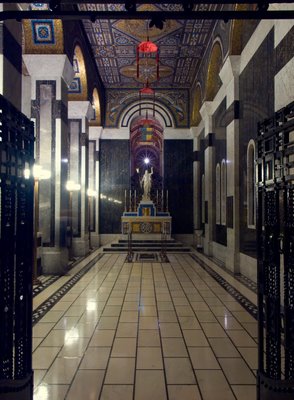
This is the All Souls Chapel at the Cathedral Basilica of Saint Louis.
Click on any photo for a larger version.
This is the most somber chapel in the Cathedral, and is a reminder for us to pray for the souls of the departed: a much neglected practice these days. The stone is mainly black and white, symbolizing death and eternal life. The crypt of the Cathedral, final resting place of some of Saint Louis' bishops, is located beneath this chapel; and memorials to these bishops are inscribed here.
The Cathedral website has some information on All Souls Chapel. That website may be wrong, however; the style of the chapel may instead be in the "Viennese Sucessionist" style, or in one of many early 20th Century Art Deco styles that died out rather quickly.
See also All Saints Chapel and Blessed Sacrament Chapel.
Other Rome of the West photo essays of the Cathedral are: here, here, here, here, here, and here.
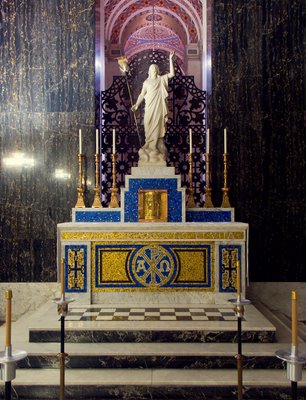
The ad orientum altar to the Risen Christ.

Statue of the Risen Christ.

The tabernacle. The bronze door shows angels holding the Body and Blood of Christ under the cross.
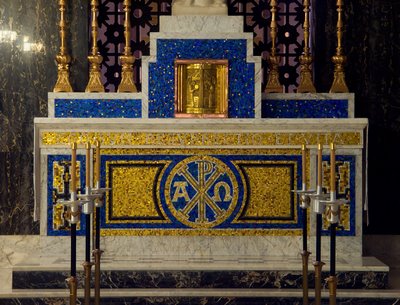
The altar.
EGO SVM RESVRRECTIO ET VITA
"I am the resurrection and the life.", John 11:25
In the center are the Greek letters Χ, Ρ, Α and Ω: Christ is the first and the last.

Above the altar is a coat of arms of one of the Archbishops. I will leave the description of its symbolism to someone more versed in heraldry.

Tomb of Cardinal Glennon.
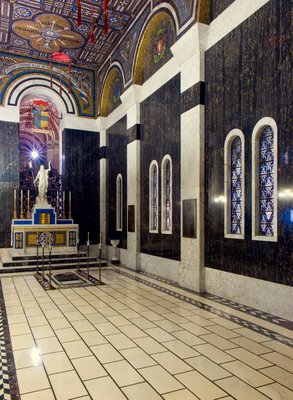
A view of the exterior wall of the chapel. The other side of the chapel is mainly open to the nave of the Cathedral.

Memorial to Cardinal Ritter, entombed below in the crypt.

Stained glass windows. These dark windows add to the somber feeling inside of the chapel.

Above the windows are mosaic coats of arms of the Archbishops.
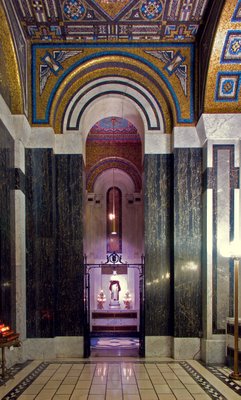
A view to the back of the chapel. Facing here is a statue of Saint Louis IX, King of France.
Note the mosaics of winged hourglasses; time flies!
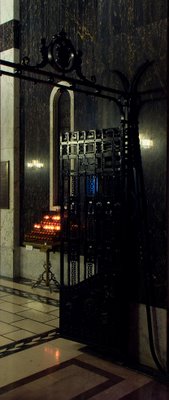
View of the ornate wrought-iron gate to the chapel, with votive candles in the background. I seem to recall, many years ago, that these gates were normally locked; they are now left open.
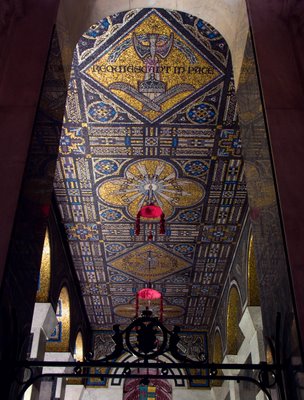
The ceiling of the chapel is more richly decorated than the walls. Suspended from the ceiling are three galeri, or ceremonial hats, of the Cardinal-Archbishops of Saint Louis. According to Wikipedia: "When a cardinal dies, it is traditional that his [galero] be suspended over his tomb, where it remains until it is reduced to dust, symbolizing how all earthly glory is passing."
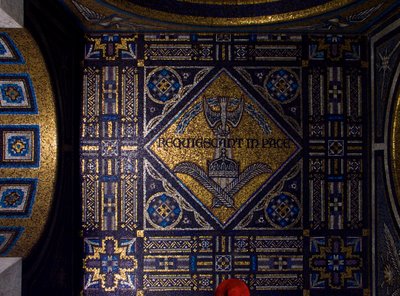
REQUIESCANT IN PACE
May they rest in peace.
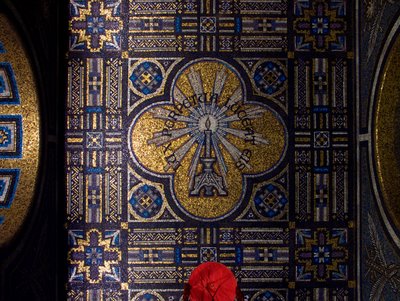
LUX PERPETUA LUCEAT EIS
"Let perpetual light shine upon them", from the introit of the Requiem Mass, said during funeral masses and on All Souls Day.

A view of the altar from outside of the chapel. Note the Jerusalem, or Crusaders' cross, on the side.


I'm completely, ragingly jealous. I'm from Milwaukee. You probably know all about OUR cathedral.
ReplyDelete“This Cathedral was restored, not without difficulty, exactly according to the norms of liturgical renewal established by Vatican Council II and solemnly and joyously inaugurated and rededicated on February 9, 2002, by the Archbishop and Ordinary, Rembert G. Weakland, OSB.
ReplyDelete-- From the Cathedral of the Archdiocese of Milwaukee.
Sorry. While I think the Chapel is both beautiful and reverent, I am tiring of the emphasis on "ad orientum" altars. I believe what takes place on an altar is infinitely more important than which way it, the celebrant, and the faithful are facing.
ReplyDeleteDear Anonymous:
ReplyDeleteI don't want you to get tired of this!
You are correct. I've seen the Mass worthily celebrated deep in a forest, and on a kitchen table in a rustic hunting cabin; also, I've heard a story about Mass in a prison cell, with the priest's hand being the chalice, and of course, Mass within tombs and catacombs, and house churches.
When the Church is under persecution, or under harsh circumstances, then I think the worthiness of the Mass is almost certainly guaranteed: in these cases, the Faith and its witness is most alive, which is why some actually welcome persecution.
But under our current circumstances, where the Church is tolerated and the Faith openly practiced, is when we have to be most concerned. Here, we have people going to church, just for the sake of appearances (and yes, I am often one of those), and we have people with all shades of political agenda attempting to subvert the Church.
It these days of often lazy faith, the art of the Church is best used to both seduce (in the Platonic sense) the lukewarm, and to hopefully convert the subversives, or at least minimize their influence.
My emphasis on the orientation of the altars is a reminder of the ancient symbols of the faith against unreasonable novelty, and is not a condemnation of the worthiness of Mass said in other circumstances.